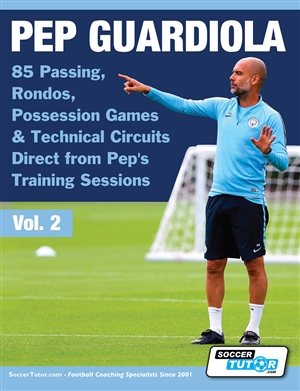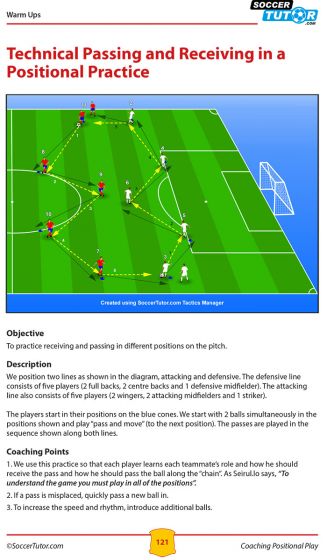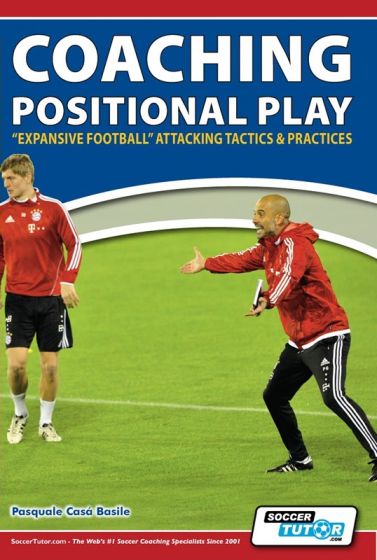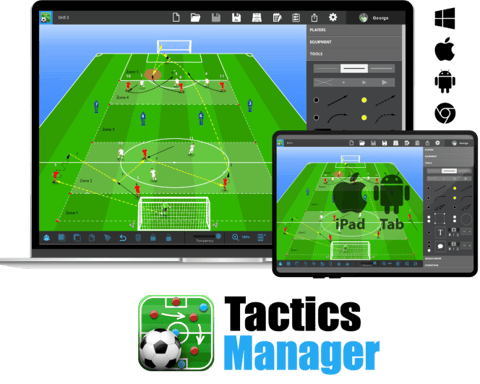The Power of the Rondo: A Comprehensive Guide to Football's Essential Drill
The Impact of the Rondo: An In-Depth Guide to a Crucial Football Drill
LEARNING
11/8/202410 min read


The Power of the Rondo: A Comprehensive Guide to Football's Essential Drill
What is a Rondo?
A rondo is an engaging possession game designed to improve players' ball control, quick decision-making, and teamwork. In this exercise, a group of attackers works together to maintain possession of a single ball while a designated defender attempts to reclaim it. Typically, the attackers outnumber the defender(s), creating a numerical advantage that promotes fluid movement and swift passing.
Rondos can be modified in various ways—by adjusting the number of players, changing the size of the playing area, or implementing specific rules. This adaptability allows coaches to emphasize different objectives, such as passing accuracy, reactions after losing the ball, and maintaining spatial awareness.
Additionally, rondos sharpen individual skills while enhancing team dynamics, making them a vital component of modern football training. Whether the goal is to foster creativity, instill discipline, or develop resilience, rondos provide a versatile and engaging method to prepare players for the challenges of the game.
After the hugely popular Volume 1, Volume 2 gives you rare insight into Pep Guardiola's Training Sessions with another chance to learn from one of the best coaches in the history of football.
Pep Guardiola 85 Practices Include:
Taken directly from Pep's training sessions at Manchester City, Bayern Munich and FC Barcelona.
A Brief History of Rondos in Football Training
The rondo originated in the 1970s at FC Barcelona, where coach Laureano Ruiz developed it as a training tool. It gained prominence under Rinus Michels, who implemented the rondo as part of his "Total Football" philosophy after taking over as Barcelona’s head coach in 1971.
Johan Cruyff, a talented player who joined Barcelona shortly after Michels, was deeply influenced by this training method. Upon returning to the club as head coach in 1988, Cruyff integrated rondos and positional play into his strategies, leading to unprecedented success, including four consecutive La Liga titles and transforming Barcelona into a powerhouse.
Pep Guardiola, a key player in Cruyff’s "Dream Team," further advanced this approach when he became head coach in 2008, achieving remarkable success and solidifying the rondo's place in football training.
Today, the rondo is widely used around the world, not only within Total Football and Positional Play but across various tactical frameworks, enhancing players' technical skills and teamwork.






The Benefits of Rondo Training
Rondo training offers a multitude of benefits for players of all ages and skill levels. Let's explore the specific advantages:
Technical Improvement
Enhanced Ball Control: Constant ball contact refines players' ability to control the ball under pressure.
Improved Passing Accuracy: Rondos encourage precise passing, helping players develop the ability to find teammates in tight spaces.
Refined First-Touch Skills: The quick nature of rondos demands immediate and accurate first touches.
Tactical Awareness
Spatial Awareness and Positioning: Players learn to occupy optimal positions on the field to receive the ball and create passing opportunities.
Decision-Making Under Pressure: Rondos force players to make quick decisions in dynamic situations.
Anticipation and Reading the Game: Players develop the ability to anticipate the movements of their teammates and opponents.
Physical Fitness
Increased Agility and Quickness: The constant change of direction and sharp movements required in rondos improve agility and quickness.
Perfect for Warm Up Phase: A simple rondo is ideal for the warm-up phase because it promotes dynamic movement, enhancing blood circulation and muscle engagement. It helps players to get into the session with smile.
Mental Fortitude
Boosted Confidence: Successful execution of intricate passes and skillful maneuvers boosts players' confidence.
Developed Resilience: Dealing with setbacks and regaining possession builds mental toughness.
Enhanced Concentration: The focus required to maintain possession in a rondo improves concentration skills.
Team Dynamics
Improved Communication and Cooperation: Rondos necessitate effective communication and teamwork.
Fostered Team Cohesion: Shared experiences and collective success strengthen team bonds.
Developed Shared Understanding: Players develop a shared understanding of tactical principles and playing styles.
This fantastic FULLCOLOUR book is written by Pasquale Casà Basile, a UEFA Pro Licence Coach and a specialist in tactics and team management. Learn how to coach positional play and develop your tactics with the Spanish game model of "Expansive Football" so your team can play effective attacking football.
This book also provides detailed analysis of 34 different tactical situations and provides 47 practices for you to use when training your team.
Rondo Variations and Their Benefits
3v1 Rondo
In a 3v1 rondo, three attackers maintain possession against a single defender. This variation enhances ball control, quick passing, and communication among players. It helps attackers practice creating space and finding passing lanes while encouraging the defender to improve their positioning and anticipation skills. This setup is ideal for developing quick decision-making and teamwork.
4v2 Rondo
The 4v2 rondo involves four attackers working together to keep the ball away from two defenders. This variation focuses on maintaining possession under pressure, emphasizing quick ball movement and effective distribution in space. It encourages players to think strategically, utilize off-the-ball movement, and make quick decisions, ultimately improving their tactical awareness.
5v2 Rondo (Midfielder in the Middle)
In this variation, four attackers surround a single midfielder in the middle, who serves as the primary link between the defenders and attackers. This presents an excellent opportunity for the player in the center to refine their movement while facing continuous pressure from the chasers.
4v4 + 3 Neutrals for Transition
In this rondo, two teams of four compete, with three neutral players who can assist either side. This format emphasizes transition between defense and attack, as teams must adapt quickly based on ball possession. Players learn to work cohesively, utilizing the neutrals strategically to maintain possession. This variation improves tactical awareness, fosters teamwork, and increases adaptability during the transition between defense and attack, and vice versa.
4v2 in One Zone with a Waiting Player
This rondo involves four attackers maintaining possession against two defenders in one zone, while a waiting player is positioned in another zone to facilitate quick transitions. Once the attackers make five passes or more they can immediately switch the ball to the waiting player, changing the zone of the possession. This variation teaches players to exploit space effectively and emphasizes the importance of quick decision-making during possession phase.
Rondo Ideas
To choose from




Designing Effective Rondos
To maximize the benefits of rondo training, it's essential to design effective drills. Here are some key considerations:
Setting Clear Objectives
Aligning with Training Goals: Ensure that your rondos directly contribute to your overall training objectives, whether it's improving technical skills, tactical awareness, or physical fitness.
Tailoring to Individual Needs: Consider the specific needs of each player and adjust the difficulty and focus of the rondo accordingly.
Choosing the Right Size
Appropriate Playing Area: The size of the playing area should be proportionate to the number of players and the desired intensity of the drill.
Player Numbers and Intensity: A larger number of players can increase the complexity and intensity of the rondo.
Setting Clear Rules
Defender Guidelines: Establish clear rules for the defenders, such as whether should the score in a small goal or run outside and etc, how many defenders are allowed, or if they must stay within a certain area.
Time Limits and Touch Restrictions: Implementing time limits or touch restrictions can increase the intensity and pace of the drill.
Incorporating Progression
Gradual Increase in Difficulty: As players improve, gradually increase the difficulty of the rondo by adding more defenders, reducing the playing area, or introducing specific challenges or constrains.
Tactical Objectives: Incorporate specific tactical objectives, such as pressing, counter-pressing, or building play from the back, to enhance the cognitive demands of the drill.
Providing Effective Feedback
Specific and Constructive Feedback: Offer clear and actionable feedback to help players improve their performance.
Encouraging Self-Reflection: Encourage players to self-assess their performance and identify areas for improvement.
Peer Learning: Facilitate peer-to-peer learning by encouraging players to provide feedback to each other.
Rondo vs. Positional Game: A Comparative Analysis
Rondos and positional games are both fundamental training methods in football, but they differ in their primary focus and objectives.
Similarities and Differences
Similarities: Both rondos and positional games emphasize possession, passing, and decision-making. They both contribute to developing technical skills, tactical awareness, and physical fitness.
Differences:
Rondos: Focus on individual technical skills, quick decision-making, and small-area play. They are ideal for developing fundamental skills and building confidence.
Positional Games: Emphasize tactical awareness, spatial organization, and collective play. They are used to practice specific formations, attacking patterns, and defensive strategies.
How Rondos Complement Positional Play
Rondos can serve as a building block for positional play by:
Developing Technical Skills: The repetitive nature of rondos helps players refine their passing, receiving, and ball control.
Improving Decision-Making: Rondos force players to make quick decisions under pressure, which translates to better decision-making in larger-sided games.
Enhancing Spatial Awareness: Rondos help players develop a sense of space and positioning, which is crucial for effective positional play.
Building Team Cohesion: Rondos can foster teamwork and communication, which are essential for successful positional play.
Integrating Rondos into a Comprehensive Training Plan
Rondos can be effectively integrated into a comprehensive training plan by:
Warm-up: Use simple rondos as a dynamic warm-up to prepare players for the training session.
Skill Development: Incorporate rondos to focus on specific technical skills, such as passing, receiving, or dribbling.
Tactical Training: Use rondos to practice tactical concepts like pressing, counter-pressing, or building play from the back.
By understanding the relationship between rondos and positional play, coaches can create well-rounded training sessions that develop both individual and collective skills.
Rondo Tips and Tricks from Professional Coaches
Insights from Top Coaches
Many top football coaches have emphasized the importance of rondos in their training sessions. Here are some insights from renowned coaches:
Pep Guardiola: Guardiola often uses rondos to develop quick decision-making, precise passing, and spatial awareness. He emphasizes the importance of varying the size of the rondo and the number of players to keep players engaged.
Jürgen Klopp: Klopp's high-intensity, pressing style is often reflected in his rondo drills. He focuses on quick transitions, aggressive defending, and winning the ball back.
Mauricio Pochettino: Pochettino's rondos often emphasize tactical concepts like pressing, counter-pressing, and building play from the back. He also uses rondos to develop the physical and mental attributes of his players.
Best Practices for Maximizing the Benefits of Rondos
Set Clear Objectives: Before conducting a rondo, determine the specific skills or tactical concepts you want to focus on.
Vary the Intensity: Alternate between high-intensity and low-intensity rondos to maintain player engagement and avoid fatigue.
Provide Constructive Feedback: Offer specific and constructive feedback to help players improve their performance.
Encourage Creativity: Create an environment where players feel free to experiment and try new things.
Progress Gradually: Start with simple rondos and gradually increase the complexity as players develop their skills.
Use Technology: Use video analysis to review and analyze rondo sessions.
Common Mistakes to Avoid in Rondo Training
Lack of Focus: Players may become distracted or lose focus during rondos.
Poor Technique: Incorrect technique can hinder player development and lead to ineffective passes and poor decision-making.
Lack of Variation: Repetitive rondos can become monotonous and lead to boredom.
Ignoring Individual Needs: Not tailoring rondos to individual player needs can limit their effectiveness.
Overemphasis on Winning: While winning is important, it should not be the sole focus of rondo training.
By following these tips and avoiding common mistakes, coaches can maximize the benefits of rondo training and develop well-rounded players.
Creative Rondo Variations
To keep your training sessions engaging and challenging, consider these creative rondo variations:
Limited-Touch Rondos
Promoting One-Touch Play and Rapid Combinations: Restrict the number of touches each player is allowed to have.
Improving First-Touch Quality: Players must develop excellent first-touch skills to maintain possession under pressure.
Directional Rondos
Developing Specific Attacking or Defensive Patterns: Force the team in possession to play in a specific direction, such as towards a particular goal or side of the field.
Simulating Match-Specific Scenarios: This variation can help players practice attacking transitions, defensive shape, and counter-attacks.
Rondos with Specific Tactical Objectives
Focusing on Pressing, Counter-Pressing, or Building Play from the Back: Incorporate specific tactical objectives into the rondo to develop tactical awareness and decision-making skills.
Real-World Application: These variations can help players apply tactical concepts to real-game situations.
By incorporating these creative variations into your training sessions, you can elevate the effectiveness of rondos and develop well-rounded players.
Conclusion
Rondo training is a powerful tool for developing a wide range of football skills, from technical proficiency to tactical awareness. By understanding the benefits and various variations of rondos, coaches can effectively incorporate them into their training sessions to enhance player development.
We encourage coaches to experiment with different rondo drills and to tailor them to the specific needs of their players. By embracing the versatility and creativity of rondos, coaches can create engaging and effective training sessions that will inspire and motivate players.
As football continues to evolve, so too will the ways in which rondos are used. We look forward to seeing the innovative ways in which coaches and players continue to explore and utilize this timeless training method.













